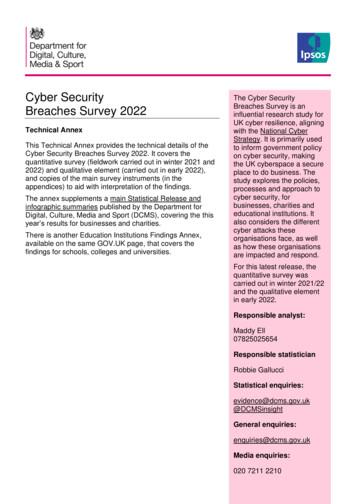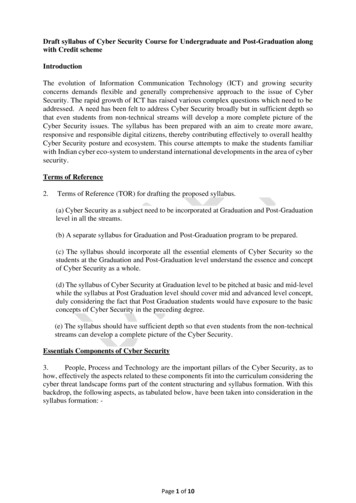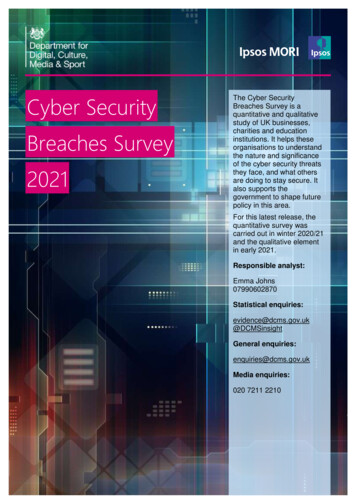
Transcription
UK Cyber Security Sectoral Analysis 2020January 2020UK Cyber SecuritySectoral Analysis 2020Research report for the Departmentfor Digital, Culture, Media and SportSam Donaldson, Perspective EconomicsJayesh Navin Shah and Daniel Pedley, Ipsos MORIDavid Crozier, Centre for Secure Information TechnologiesProfessor Steven Furnell, University of Plymouth
UK Cyber Security Sectoral Analysis 202018-096070-01 Version 1 Public This work was carried out in accordance with the requirements of the international quality standard for Market Research, ISO 20252, and with the Ipsos MORI Termsand Conditions which can be found at http://www.ipsos-mori.com/terms. DCMS 2020
UK Cyber Security Sectoral Analysis 2020ForewordTo help meet this challenge, we have invested in twoworld-leading innovation centres in London andCheltenham, and have provided a range of support forentrepreneurs, start-ups and for the commercialisation ofacademic research to grow and strengthen the cybersecurity sector. We have also made the case to businessesand individuals to practice cyber hygiene, throughinitiatives such as Cyber Essentials.The UK is one of the world’s leading digital nations, hometo exceptional talent, cutting-edge innovation and rapidgrowth. In 2016, the Government published its NationalCyber Security Strategy (2016-2021), where we set out ourcommitment to defend our systems and infrastructure,deter adversaries, and to develop a whole-societycapability to protect our digital economy.Since then, we have invested significantly - with 1.9bnallocated to the strategy - in supporting the developmentof the UK’s cyber security ecosystem. The National CyberSecurity Centre (NCSC), officially opened in February 2017,has provided world-class, user-friendly expertise forbusinesses and individuals and has also been at theforefront of protecting the UK from online threats,handling well over six hundred incidents in 2019 1 alone.We know that Government cannot work alone in tacklingthe cyber threat, and that we must do all we can tosupport commercial innovation, academic know-how, andAs this research shows, there has never been greaterdemand, both at home and internationally, for theproducts, services and expertise offered by the UK cybersecurity sector. Over the last two years, there has clearlybeen significant progress within the sector, which hasreported double-digit annual revenue and employmentgrowth, as well as record investment in early-stagecompanies.Much has been achieved through the National CyberSecurity Strategy, and the strength and dedication of ourcommercial sector clearly underpins the UK’s efforts to beone of the safest places to live and work.Government will continue with its efforts to support theUK’s world-leading cyber security sector to remaininternationally competitive, to develop innovative andground-breaking new products and services, to expandand access new markets, and to secure the best talentavailable to ensure sustainable growth.to promote clear routes to develop and harness asustainable talent pipeline in cyber security.When Government launched the National Cyber SecurityStrategy (NCSS), we set out the challenges often faced bythe cyber security sector. We identified a need to helpThe Rt Hon Matt Warman MPwell as to support early-stage companies secureMinister for Digital and Broadbandnew innovative products and services reach the market, asParliamentary Under Secretary of Stateinvestment for developing, testing and expanding theiroffer.1National Cyber Security Centre (2019) Annual Review: https://www.ncsc.gov.uk/news/annual-review-2019
UK Cyber Security Sectoral Analysis 2020ContentsExecutive Summary . 11 Introduction . 41.1Methodology & Sources Used . 51.2Consistency & Differences with the Baseline Cyber Security Sectoral Analysis . 91.3Interpretation of the data . 101.4Acknowledgements . 102 Profile of the UK Cyber Security Sector . 112.1Defining the UK Cyber Security Sector . 112.2Number of Cyber Security Firms Active in the UK . 122.3Products and Services Provided by the Cyber Security Sector . 192.4Geographic Location of the Cyber Security Firms in the UK. 233 Economic Contribution of the UK Cyber Security Sector . 273.1Estimated Revenue . 273.2Estimated Employment . 313.3Estimated Gross Value Added (GVA) . 353.4Summary of Economic Contribution. 364 Investment in the UK Cyber Security Sector . 374.1Introduction . 374.2Company Evolution and Company Exits . 424.3Company Exits . 434.4Valuation . 434.5Forms of Investment and Sources of Funding . 435 Understanding Market Growth . 445.1Overview of Growth Since Baseline (2017) . 445.2Reasons for Market Growth . 455.3Barriers to Growth . 526 Government Support for the Cyber Security Sector . 536.1Overview of Sectoral Support . 536.2What has the support provided meant for the cyber security sector? . 557 Conclusions . 637.1Overview of the Size and Scale of the UK Cyber Security Market . 637.2Opportunities and Challenges for the Cyber Security Sector . 65Appendices . 67A: Report References . 67B: Overview of Sources . 68C: Taxonomy and Definitions. 69D: Survey Methodology and Interpretation . 70
UK Cyber Security Sectoral Analysis 2020E: Inclusion / Exclusion Criteria for Defining Cyber Security List . 71F: Stage of Evolution Definitions . 72G: Key Metrics: Change since Baseline (2017) . 73List of figuresFigure 2.1: Sankey Diagram: Cyber Security Entrants and Exits since Baseline . 13Figure 2.2: Number of Registered Firms by Region . 14Figure 2.3: Number of Firms by Size . 15Figure 2.4: Change in Size (Since Baseline) . 16Figure 2.5: Percentage of Dedicated and Diversified Cyber Firms . 17Figure 2.6: Percentage of Dedicated and Diversified Firms (by Size). 17Figure 2.7: Percentage of Firms by SIC Code . 18Figure 2.8: Categorisation by Product, Service or Other . 20Figure 2.9: Percentage of Firms Providing a Product or Service aligned to Taxonomy . 21Figure 2.10: Percentage of Businesses with a Sector Focus (Customers) – Survey Estimates . 22Figure 2.11: Registered Location of Cyber Security Firms . 23Figure 2.12: Number and Percentage of Registered and Trading Locations (Offices) . 24Figure 2.13: UK Headquartered Businesses with an International Presence (i.e. Office Location) . 25Figure 3.1: Total Cyber Security Revenue by Size of Firm . 28Figure 3.2: Total Cyber Security Revenue by Size and by Dedicated / Diversified status . 29Figure 3.3: Total Cyber Security Revenue by Product / Service Offer . 30Figure 3.4: Percentage of Cyber Security Employment by Region (Registered Location). 31Figure 3.5: Percentage of Cyber Security Employment by Region (Estimated). 32Figure 3.6: Total and Average Number of Employees by Firm Size . 33Figure 3.7: Total Number of Employees by Dedicated / Diversified Status . 34Figure 3.8: Percentage of Cyber Security Employment by Product / Service Offer . 34Figure 3.9: Estimated Gross Value Added by Size of Firm . 35Figure 3.10: Estimated Gross Value Added by Dedicated / Diversified Status . 36Figure 4.1: Total Investment to Date .38Figure 4.2: Total Investment (Volume and Number) by Region (since 2017) . 39Figure 4.3: Investment by Company Size (since 2017) . 40Figure 4.4: Investment by Product / Service Offer (since 2017) . 41Figure 4.5: Value of Investment by Product / Service Offer (since 2017) . 41Figure 4.6: Stage of Evolution at First Deal Date vs Current Stage of Evolution. 42Figure 5.1: Timeline of Notable Cyber Security Incidents and Events in the UK . 46Figure 5.2: Cyber Security Contracts (Value and Volume). 49Figure 5.3: UK Cyber Security Exports (2016-18) and Forecast to 2023. 50Figure 5.4: Proportion of Turnover Attributable to Exports for UK Cyber Security Firms – Survey Estimates. 51Figure 5.5: Percentage of Companies that Export to the Following Regions - Survey Estimates . 51Figure 5.6: Perceived Barriers to Growth for Cyber Security Firms – Survey Estimates. 52Figure 6.1: Comparison in Average Firm Level Revenue (Baseline and Current) . 60Figure 6.2: Comparison in Gross Value Added (GVA) (Baseline and Current) . 61Figure 6.3: Comparison in Cyber Security Employment (Baseline and Current) . 61Figure 6.4: Investment Received by Companies involved in a Government Initiative . 62
UK Cyber Security Sectoral Analysis 20201Executive SummaryIntroductionIpsos MORI, in conjunction with Perspective Economics, the Centre for Secure Information Technologies (CSIT)at Queen’s University Belfast, and Professor Steven Furnell (University of Plymouth) were commissioned by theDepartment for Digital, Culture, Media and Sport (DCMS) in January 2019 to undertake an updated analysis ofthe UK’s cyber security sector.This analysis builds upon the baseline UK Cyber Security Sectoral Analysis (published in October 2018 2) thatprovided an estimate of the size and scale of the UK’s cyber security industry. This provided a baseline (using2015/16 financial data) for the number of UK cyber security companies; the cyber security sector’s contributionto the UK economy (through revenue and GVA); the number of personnel employed in the cyber securitysector; and an overview of the products and services offered by these firms.As the UK’s National Cyber Security Strategy 3 (NCSS) runs until 2021, this analysis effectively provides a mid-point review of the current size and scale of the UK’s cyber security sector.Project Scope & Summary of MethodologyThe following diagram sets out a summary of the research methodology utilised.Source: Ipsos MORI, Perspective Economics, and the Centre for Secure Information Technologies (2019)2Donaldson, S, Hobson, J., Stow, C, and Crozier, D., (2018) ‘UK Cyber Security Sectoral Analysis’. Available yber-security-sectoral-analysis3UK Government (2016) ‘National Cyber Security Strategy – 2016-2021’: Available at: l-cyber-security-strategy-2016-to-2021
2UK Cyber Security Sectoral Analysis 2020Key FindingsNumber of CompaniesWe estimate that there are 1,221 firms active within the UK providing cybersecurity products and services (2019). This reflects an increase of 44% since the baseline report (846 firms).In the last two years, we have identified 118 new business registrations within thecyber security sector. In other words, a new cyber security business is registered every weekwithin the UK.90% of the sector consists of SMEs, with an associated estimated turnover of 2bn (24% of the sector’s revenues).Sectoral EmploymentWe estimate there are approximately 43,000 Full Time Equivalents (FTEs)working in a cyber security related role across the cyber security firms identified. This reflects an estimated increase of 37% in employee jobs over the lasttwo years.The majority (65%) of cyber security employment is based within large firms.Sectoral RevenueWe estimate that total annual revenue within the sector has reached 8.3bn. This reflects an increase of 46% since the 2017 baseline analysis (i.e.revenue has increased by 2.6bn from 5.7bn).On average, we estimate that revenue per employee has reached 193,500 (an increase of 7% since baseline).Gross Value AddedWe estimate that total Gross Value Added (GVA) for the sector reached 3.77bn. This means total GVA has increased by 60% in the last two years, from 2.35bn).GVA per employee has reached 88,000 (an increase of 17%).Products and ServicesThe most commonly provided cyber security products and services (see Section2.3) by the sector include: Cyber Professional Services (provided by 71% of firms)Threat Intelligence, Monitoring, Detection and Analysis (46%)Endpoint Security (including Mobile Security (37%)Emerging Sub-Sectors: IoT Security, SCADA and ICS, Post-Quantum Cryptography
3UK Cyber Security Sectoral Analysis 2020Growth DriversThe cyber security sector has grown through both increased domestic demand(particularly driven by the implementation of GDPR) and through increasedexports.Further, external investment and increased procurement of cyber securityproducts and services has also helped to increase demand and growth withinthe sector (see Section 4.2).InvestmentSection 4 (Investment in the UK Cyber Security Sector) demonstrates that: 2019 was a record year for cyber security investment, with 348m infundraising across eighty deals.Indeed, over the last four years (2016-19), total external investment identifiedwithin the cyber security sector has exceeded 1.1bn, demonstrating howinvestment and confidence has grown in recent years.Industry SupportThe UK Government has invested in a range of initiatives to help cyber securitystart-ups, early-stage companies, and high growth companies develop marketleading products and secure external investment.This research highlights that these initiatives have a key role to play in helping to: develop new products and services (particularly innovative products thatcan tackle new cyber security challenges);connect high-potential, high-growth businesses with investors; anddevelop a more coherent ecosystem of cyber security providers, throughpromoting collaboration and mentoring.
4UK Cyber Security Sectoral Analysis 20201 IntroductionIpsos MORI, in conjunction with Perspective Economics, the Centre for Secure Information Technologies (CSIT)at Queen’s University Belfast, and Professor Steven Furnell (University of Plymouth) were commissioned by theDepartment for Digital, Culture, Media and Sport (DCMS) in January 2019 to undertake an updated analysis ofthe UK’s cyber security sector.This analysis builds upon the baseline UK Cyber Security Sectoral Analysis (published in October 2018 4) thatprovided an estimate of the size and scale of the UK’s cyber security industry. This provided a baseline (using2015/16 financial data) for the number of UK cyber security companies; the cyber security sector’s contributionto the UK economy (through revenue and GVA); the number of personnel employed in the cyber securitysector; and an overview of the products and services offered by these firms.As the UK’s National Cyber Security Strategy 5 (NCSS) runs until 2021, this analysis effectively provides a midpoint review of the current size and scale of the UK’s cyber security sector.Setting the Scene: “A burgeoning and innovative cyber security sector is anecessity for our modern, digital economy. UK cyber security firms provideworld-leading technologies, training and advice to industry and government.But whilst the UK is a leading player, it faces fierce competition to stayahead ”Objective: The Government willsupport the creation of a growing,innovative and thriving cyber securitysector in the UK in order to create anecosystem where:Measuring Success: The Governmentwill measure its success in stimulatinggrowth in the cyber security sector byassessing progress towards thefollowing outcomes: security companies prosper, and greater than average globalget the investment they need togrow the best minds from government,academia and the private sectorcollaborate closely to spurinnovation customers of the Government andindustry are sufficiently confidentand prepared to adopt cuttingedge services.growth in the size of the UK cybersector year on year a significant increase in investmentin early stage companies adoption of more innovative andeffective cyber securitytechnologies in Government.With respect to measuring success, this report focuses upon understanding how the sector has grown year-onyear, and how early-stage companies have been able to secure investment and support.4Donaldson, S, Hobson, J., Stow, C, and Crozier, D., (2018) ‘UK Cyber Security Sectoral Analysis’. Available yber-security-sectoral-analysis5UK Government (2016) ‘National Cyber Security Strategy 2016-21’ Available at: l-cyber-security-strategy-2016-to-2021
UK Cyber Security Sectoral Analysis 202051.1 Methodology & Sources UsedThe UK Cyber Security sector does not have a formal Standard Industrial Classification (SIC) code, and thisstudy therefore closely aligns itself to that of the baseline analysis, in order to provide a time-series analysis ofhow the sector has progressed since baseline (2017).The following methodology and research sources were used to provide an overarching shortlist of UK cybersecurity businesses, and to estimate their economic contribution related to the sale of cyber security productsor services.Stage 1: Desk ResearchThe research team conducted initial desk research to explore how the cyber security market had changedwithin the last two years. This included a review and identification of: UK cyber security regional networks and clusters (e.g. CyberExchange 6, Cyber Resilience Alliance7, SouthWales Cyber 8 etc.) published reports regarding the output or activities of the sector (e.g. UK Cyber Security ExportsStrategy 9 and associated annual export statistics 10, the UK Cyber Security Skills Strategy 11, and the UKCyber Security Breaches Survey 12) recent investments or initiatives in the cyber security sector (including review of investments andacquisitions, and identification of new industry initiatives e.g. Tech Nation Cyber 13) any emerging trends in the market (including supply-side and demand-side) e.g. enhanced demandattributable to GDPR compliance, or new product innovations requiring specific cyber securityrequirements (e.g. IoT security).Stage 2: Taxonomy ReviewSubsequently, a taxonomy review workshop was held in February 2019 with members of industry, Government,academia and representative bodies to test how the cyber security market should be defined and categorised(as of 2019). This provided an updated taxonomy and definitional terms to be used to identify a long-list ofpotential cyber security firms in the UK.678910Cyber Exchange: https://cyberexchange.uk.net/#/homeCyber Resilience Alliance (Gloucestershire, Worcestershire, The Marches, and Swindon & Wiltshire LEPs): https://www.cyberresiliencealliance.org/South Wales Cyber Security Cluster: https://southwalescyber.net/UK Government (2018) Cyber Security Export Strategy: Available at: ecurity-export-strategyDepartment for International Trade / Defence and Security Organisation (2019) ‘UK Defence and Security Export Statistics for 2018’ Available d-security-export-statistics-for-201811Department for Digital, Culture, Media and Sport (2019)’ Cyber Security Skills Strategy’ Available r-security-skills-strategy12DCMS, Ipsos MORI, and University of Portsmouth (2019) ‘UK Cyber Security Breaches Survey 2019’ Available security-breaches-survey-201913Tech Nation (2019) Cyber Cohort: Available at: https://technation.io/programmes/cyber-security/
UK Cyber Security Sectoral Analysis 20206Stage 3: Initial Data Collection & Gap AnalysisThe research team subsequently sought to identify potential active cyber security firms in the UK through: a review of the baseline firms (identifying the current status and determining inclusion in the updated set) a review of company participation within clusters, networks, and/or government supported initiatives a revised search strategy (using BvD FAME and wider search strategy).A long-list was subsequently tested and refined to a final working list for the sectoral analysis. This list was thensubject to extensive data gathering to identify metrics including (but not limited to): company name, registered number, company status, and date of incorporation registered and trading locations company website and contact details core description of company activities related to cyber security company size (large / medium / small / micro) participation within government supported initiatives (e.g. NCSC Cyber Accelerator) to support the cybersecurity sector was also flagged at this stage.Stage 4: Cyber Security Sector SurveyIpsos MORI carried out a representative survey of 262 cyber security firms from 1 May to 25 June 2019. Thesurvey used the list of firms established in stage 3 of this study as a sample frame. The purpose of the surveywas to collect data directly from the firms that could not be found in stage 3 of this study. It covered thefollowing topics: the categories of products and services offered across firms the client sectors that cyber security firms work across revenue estimates (to supplement the other published data found in stage 3) international trade status perceived barriers to growth among the subgroup of firms that had participated in various Government-backed cyber growthschemes (HutZero, Cyber 101, Cyber Security Academic Startup Accelerator Programme (CyberASAP),NCSC Cyber Accelerator, and the London Office for Rapid Cybersecurity Advancement (LORCA)), theactions they had taken off the back of this scheme participation.Appendix D provides the full technical details for the survey, including the data collection approaches andresponse rate.
UK Cyber Security Sectoral Analysis 20207A note on comparisons to the baseline Cyber Security Sectoral Analysis surveyAs discussed in Section 1.2, this survey is very different to the one carried out in the baseline sectoral analysis(published in October 2018). The differences include: data collection mode and sampling approach – primarily telephone this time with a random-probabilitysampling approach, as opposed to the self-selecting online sample achieved in the previous analysis questionnaire – an entirely revamped questionnaire was used this time sample size – this year’s survey achieved a much larger sample size (262, vs. c. 80 previously).These major differences mean that none of the survey estimates from this year should be considered directlycomparable to the ones in the baseline sectoral analysis.Stage 5: ConsultationsThis research has also been supported by a series of extensive one-to-one consultations with policy andoperational leads (for cyber security policy, and for a number of Government-supported initiatives to grow thecyber security sector), industry, and academics.Stage 6: Data BlendingIn August 2019, the results of the cyber security sector survey were utilised to inform gaps within the initiallong-list of cyber security sector firms e.g. the extent to which a firm provided cyber security products orservices and attributed revenues accordingly, or indeed, where a firm had received support from an initiativeintended to help the sector – this includes their views on how support has helped them to grow.This stage involved thorough data cleaning and joining to provide a final dataset of cyber security firms, and agranular (known and/estimated) profile of which firms are involved in cyber security, to what extent (toattribute employment, revenue, GVA etc), what firms offer to the market (within the taxonomy), and wherefirms have secured investment.Stage 7: Data Analysis and ReportingThe final stage involved analysis of the final shortlist of firms to provide estimates of total number of firms,products and services offered, whether firms are ‘dedicated or diversified’ with respect to how much of theiractivity related to cyber security provision, revenue/GVA/employment estimates, locations (registered, tradingand international presence), investment and survey feedback (anonymised at an individual level). The analysiswithin this report is consistent with the baseline.
UK Cyber Security Sectoral Analysis 20208Data Sources UsedThe data so
2015/16 financial data) for the number of UK cyber security companies; the cyber security sector's contribution to the UK economy (through revenue and GVA); the number of personnel employed in the cyber security sector; and an overview of the products and services offered by these firms. As the UK's National Cyber Security Strategy. 3










